
India’s Electric Vehicle (EV) market is growing rapidly, with around 2 million vehicles expected on the road by 2026. To meet their charging requirements, it is estimated that the country will need 400,000 stations and, as 80% of charging takes place at home, Resident Welfare Associations (RWAs) will soon be expected to provide the necessary infrastructure.
This document contains all the information an RWA needs to know on EV charging infrastructure, from why it’s needed and its costs to implementation and safety precautions to be taken. We have also included information that would be useful in selecting a configuration for your society and answered queries likely to be brought up by the wider resident body.
RWAs & EV charging infrastructure
Only a small number of RWAs today offer charging infrastructure, but this is changing rapidly as sales increase and the government, too, makes charging infrastructure more attractive. Several states have already released EV policies to increase uptake of EV infrastructure. Incentives range from financial incentives (Maharashtra and Delhi) on installing charging stations to providing property tax rebates to societies. A few state distribution companies (e.g. DISCOMs) are providing dedicated connections for EVs with subsidised tariffs.
1. Current legislation
The Ministry of Housing and Urban Affairs (MOHUA) amended its Model Building Bye Laws (MBBL) 2016, to recommend that 20% of all parking spots be equipped with EV charging. It also states that the building premises will have to have an additional power load, equivalent to the power required for all charging points to be operated simultaneously, with a safety factor of 1.25. The amendments are applicable to all buildings except independent residences.
Going forward, EV charging would be a mandatory requirement for new buildings as well as existing ones. Impending Government of India regulations mandate installation of charging points in housing societies, provision of power backup and allocation of a certain amount of dedicated power for charging EVs.
The Ministry of Power’s recent guidelines mandate all states to notify EV charging infra mandates for RWAs, office spaces and commercial establishments with parking provision. Over the next 6-12 months, there will be compliance requirements that every RWA will have to adhere to.
2. Growing interest among RWAs
A recent survey conducted by MyGate among 500+ RWAs confirms that more of them are interested in installing EV charging infrastructure within their societies in response to growing EV adoption among their residents.
Box 1.1: Results of survey conducted by MyGate among RWAs
3.2% of the societies have already installed EV charging infrastructure
24% of the societies plan to install EV charging infrastructure in the next 6 months
21% of them aim to install it in the next 6-12 months
30% of the societies surveyed plan to install EV charging infrastructure in the next 3 years
33% RWAs in Mumbai & 31% in Pune aim to install EV charging infra in the next 6 months
40% RWAs in Bangalore and 37% in Pune aim to install EV charging infrastructure in the next 1-3 years
Currently installed infrastructure was highest in Bangalore (8%) followed by Pune (3%) and Delhi (2%)
3. Challenges
The Automotive Research Association of India (ARAI) recommends using electric vehicle supply equipment (EVSE) to charge any EV safely. But most RWAs today are not providing exclusive infrastructure for EV charging.
Since EV ownership is still nascent, the need for EV charging is still considered an individual one. Most EV owners are currently charging their EVs through common power sockets in the society parking. Others take a direct electric line from their existing residential connection to their parking lots where they use 15A/240V sockets for charging. A few 2-wheeler EV users (with removable batteries), charge the batteries in their homes. Such ad-hoc solutions are a logistical challenge for residents and are not designed for safe EV charging. They could lead to a lot of unsafe wiring, posing risks of fire accidents and electricity load issues during peak usage. As EV adoption increases, it could become a potential hazard. Neither of these approaches is scalable or sustainable.
A few RWAs have set up community charging sockets where several vehicles can be charged simultaneously at one location, but they face challenges in metering and billing of users.
Box 1.2: How to safely allow residents to draw power directly from their homes to their parking lots
RWAs need to carefully evaluate the safety concerns arising from ad-hoc electrical connections. Consider the following safety guidelines:
– Define cabling standards for residents to follow during private installations
– Route the cabling through your electrical contractor or have the implementation monitored by your electrical supervisor to avoid any potential threats
– Install a low cost charge point with adequate safety layers to protect against load surges and voltage fluctuations. Charge points with auto-power cutoff options on full charge and additional safety features are safer than a regular 16A socket
4. Available solutions
Every RWA should plan its charging roadmap right from the initial adoption stage. Once a society has 5-10 EVs, it can install common charge points in the community/ visitor parking lots. Installing community chargers will encourage more residents to make the switch to EVs.
Electric vehicle charging is available at three levels based on the rate at which a vehicle is able to recharge. Higher levels indicate faster charging rates but are also typically costlier and may require upgrades to a site’s electrical infrastructure. The following sections provide a brief overview of the various levels of EV charging.
Table 1.1: Comparison between different charging methods
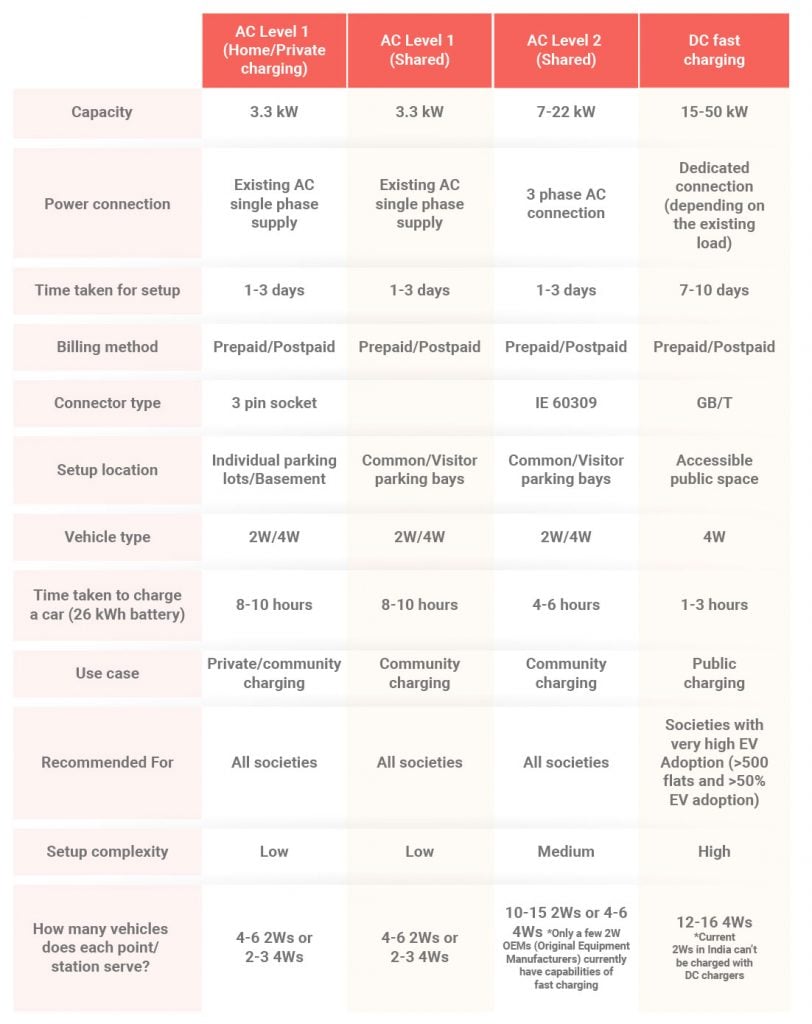
Table 1.2: Installation, setup and maintenance costs for charging stations
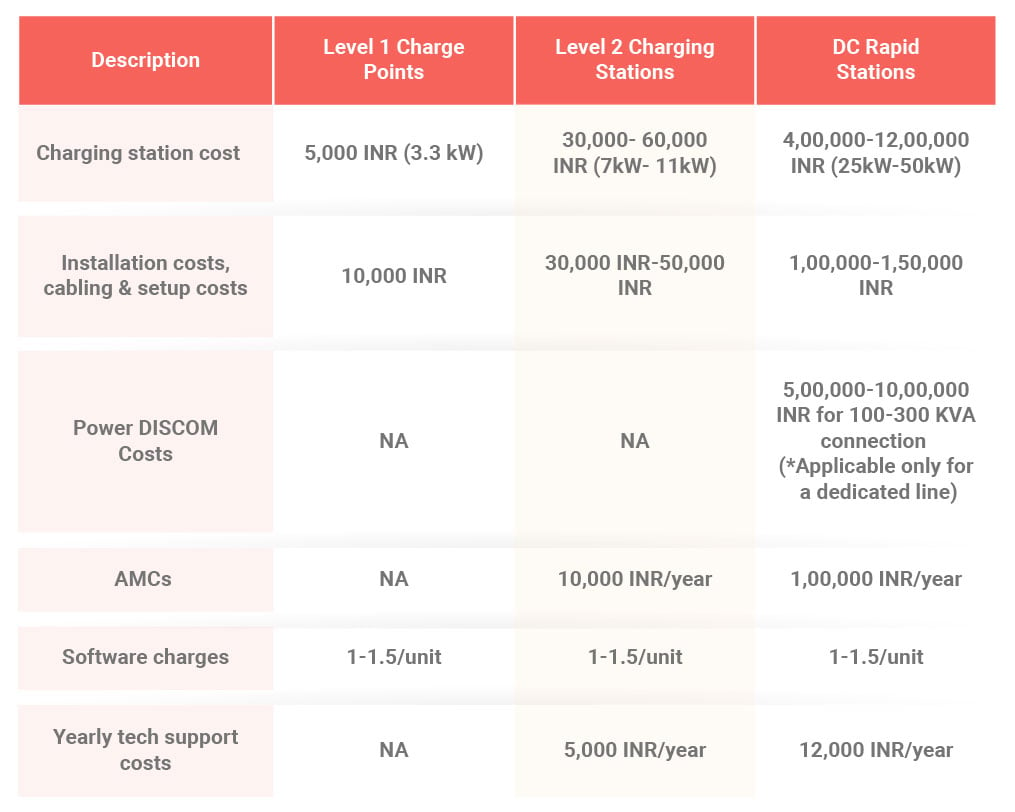
Box 1.3: Common pitfalls to avoid
1. DC rapid charging
This is the fastest EV charging option and an expensive one, costing between INR 5,00,000 – 10,00,000/charging station and it requires significant upgrades to a site’s electrical system. Current DC charging stations in India are designed only for 4-wheeler charging and they aren’t compatible with 2 wheelers. Further, not all EVs are equipped with the hardware required for DC charging. For certain battery types, DC charging reduces overall battery life and should be used only for emergencies or out station travel.
Each DC charger can fully charge upto 16 vehicles (4W) in a day and a society can choose to install 1/2 DC chargers on its premises for emergency fast charging. For the initial adoption phase it is recommended to opt for AC level 1 & level 2 charging stations. However, RWAs with >500 flats can consider upgrading to DC Rapid infra when the EV adoption is >30-50% & there is a requirement from residents for rapid charging.
2. OEM-specific charging stations
Few vehicle manufacturers (2W/4W) are also deploying their own charging stations for community charging which are compatible only with their vehicles. While individual residents are free to choose OEM-specific chargers for their personal charging needs in their private parking lots. However, RWAs can avoid installing them for community charging. Choose chargers that are OEM agnostic and suitable for all vehicle makes and types.
Implementing charging infrastructure
RWAs looking to install EV charging stations in their apartments can follow the steps outlined below:
1. Estimating demand
Conduct a resident survey to estimate the current demand for EV charging and anticipated future demand. Keep in mind that EV adoption is expected to grow rapidly as more models become available and there is a wider acceptance of EVs. Based on the current and anticipated number of EVs, estimate the peak electricity requirement.
Individual charging points or community charging stations?
RWAs can adopt a phased strategy for installing EV charging infra. When the adoption levels of EVs are less than 5%, RWAs can make common charging points stations available for residents. However, this isn’t sustainable as EV adoption increases. A long-term and more convenient solution would be to provide charge points in the private parking lots of residents preferably from the available spare load or through a dedicated EV connection from the power distribution companies (DISCOMs). In bangalore it is BESCOM). RWAs can also make provisions from individual meters for low adoption phases. However, while considering this option remember that this might cause safety issues if the cabling process is not standardised. Please consult your electrical contractor and evaluate future safety and scalability issues before going ahead with connections from individual meters.
Table 2.1: Three-phase charging roadmap for RWAs
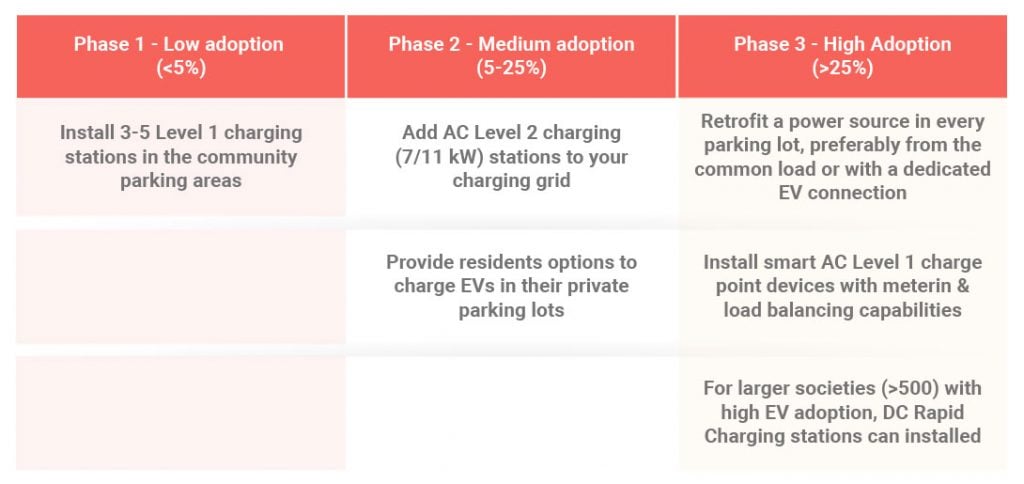
Table 2.2: Comparison between private and community charging
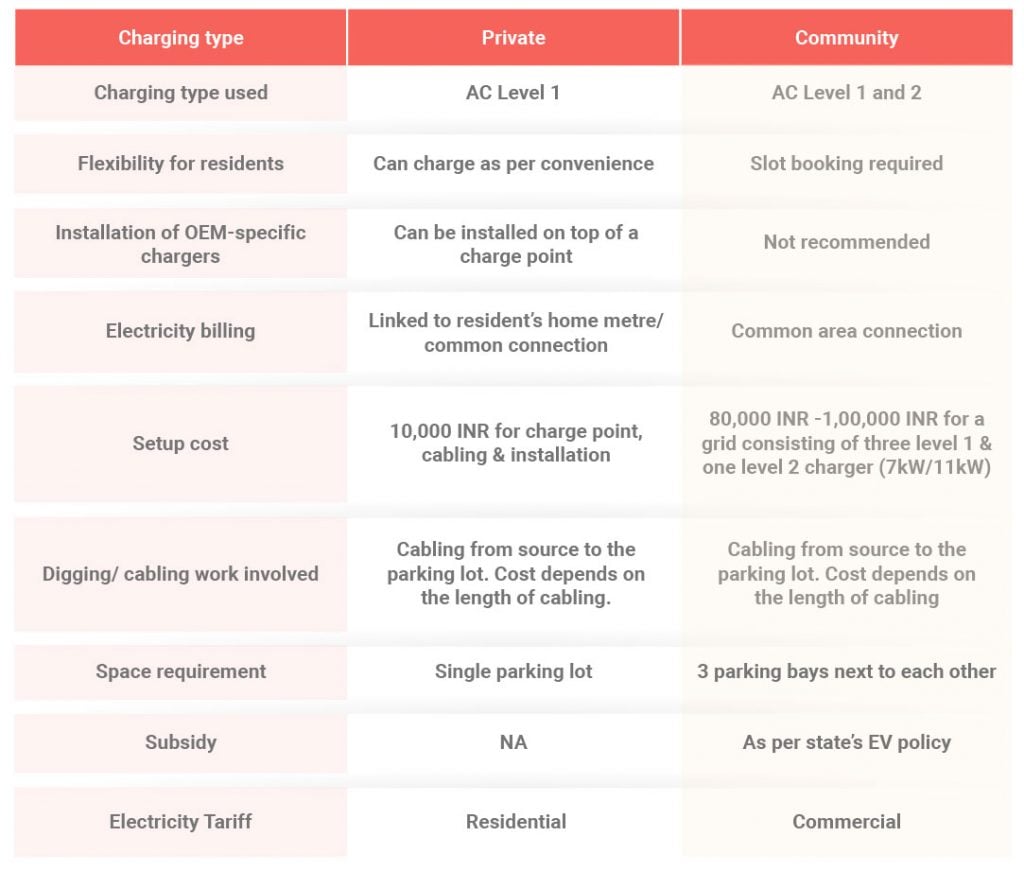
Box 2.1: Licenses and permissions
For private and community charging using the existing connection or spare load, no permission is required from DISCOMs. However, in case an RWA chooses to take a dedicated connection for EV charging and avail special tariffs or subsidies, it will require an approval from the DISCOM for the new connection.
2. Deciding ownership model
Have an electrician/EV charging provider evaluate your property to determine if EV chargers will need to have electricity supplied from a common load meter or if it is possible to have EV chargers individually metered. The metering arrangement will largely drive the decision on your grid design. A feasibility check of existing load capacity will also need to be conducted of charger types, cable size and load capacity of the society. Evaluate your peak load requirements considering various levels of EV adoption & plan backwards.
Box 2.2: Steps to perform a feasibility check
1. Calculate the additional peak load required depending on the number of EVs in your society. For eg. if you have 30 4W EVs and 20 2W EVs, your peak load requirement would be 130 kW (For 4W – 30*3.3 kW = 99 kW + For 2W- 20*1.5 kW = 30 kW)
2. Most RWAs have a common spare load which can be used for community charging stations. This does not require special permission from DISCOMS
3. Divide the spare load available to the rating of the charger. This will give you the exact numbers of chargers that can be placed. If 100 kW of load is available, you can install 5 Level-2 chargers of 7 kW and 20 Level-1 charge points of 3.3 kW
4. Based on load, determine the size and type (aluminium/copper) of the cables
5. Divide the whole basement into multiple zones depending on the area. Determine the source of power. Lay down proper cables and establish junction boxes
6. From the junction boxes, place proper cables to the charging points for individual charging points
7. RWAs can set up Level 1 and 2 charging points with the society’s spare load and upgrade their infra once EV adoption increases
3. Electricity requirements
Determine how electricity will be supplied to EV chargers. RWAs can use power either from the existing common load or from individual meters. Keep in mind future grid monitoring and load balancing capabilities that will be needed as EV adoption among residents rises.
If there is existing spare load for setting up community charging stations, RWAs will have to provide a reliable power source and the service provider can take care of cabling and charge point installation work.
In case the existing load isn’t sufficient, RWAs will have to apply for a new connection for EV charging and hire an electrical contractor to provide a power source close to the charge point locations for the CPO to install charge points/stations. There are service providers available in the market who can take up turnkey projects for end to end implementation too (which includes liaising with your DISCOMs and setting up the entire infra).
Box 2.3: Common questions about electricity supply
Can EV chargers be solar powered?
EVs can be charged from any power source which provides a minimum output of 3.3 kW (power from a normal 16A socket). Level 1 and Level 2 chargers can be conveniently plugged to a solar connection. However, for DC rapid charging solar power might not provide sufficient load (in an RWA setup).
What can be done with the spare capacity available in the sanctioned electricity load for the society?
RWAs can conveniently install community charging stations from their available spare load after accounting for sufficient factor of safety for peak loads.
How can RWAs maximise their load to EV charging station ratio?
A few service providers have smart grid and load management capabilities which maximise the number of vehicles that can be charged simultaneously by adding a layer of smart load controllers on your grids.
GoI mandates smart metering for new connections. What will be the future impact of this on EV charging?
Indian power DISCOMs will soon charge variable tariffs for electricity usage depending on load peaks. While considering different options for EV charging, ensure your service provider’s software is intelligent enough to optimise vehicle charging depending on the tariff rate and ensure that the bulk of the charging is done during non-peak hours.
4. Scope of work
Table 2.3: SOW & responsibility matrix

* Cabling and DISCOM charges are subject to metal price variation
5. Cost sharing
Once the general design of your EV charging setup is ready, research available government subsidies and property tax rebates and determine who will cover the costs of each component. A few questions to consider:
- Will the RWA cover the cost of electrical upgrades and conduit, while individual residents purchase and pay for installation of their own EV charger?
- Will the RWA recover these costs through increased maintenance fees or will the residents share the initial setup costs ?
- Will the RWA work on a CAPEX/OPEX (capital expenditure/ operating expenditure) model with a Charging Point Operator (CPO)?
For the initial phase of adoption for installing level 1 and level 2 chargers, the investment on infrastructure is low. Hence societies can utilize their available corpus from the maintenance budgets. As EV adoption increases (>25% residents), RWAs can undertake the future-proofing work and split the cost among the residents. Refer to table 3.1 for a sample calculation.
Table 2.4: Evaluating capex and opex models
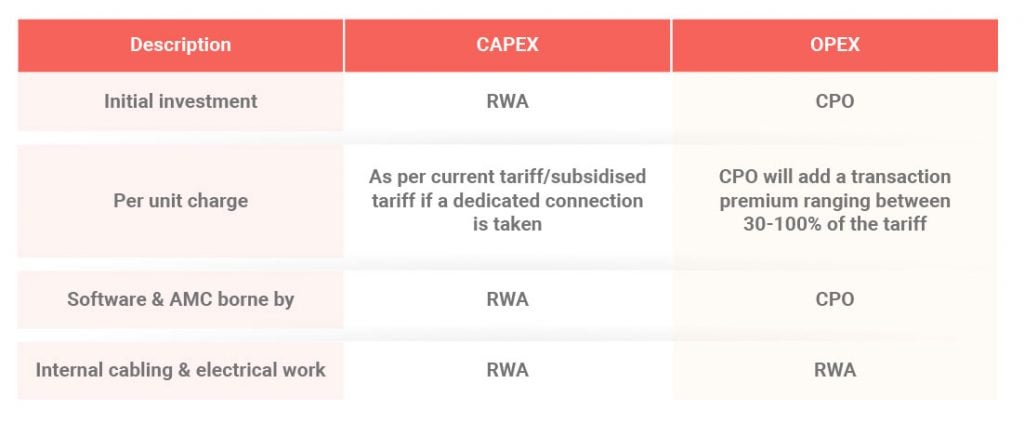
Recommendation – The cost benefits of EV charging for residents (in comparison with fuel prices) can be attained only when daily costs of vehicle charging are low and affordable. Opex models, though initially attractive, will make the recurring payments a burden later. Given that the initial capex required for AC Level 1 and Level 2 charging is not very high, RWAs can choose Capex models over Opex.
6. Locations for charging stations
EV charging requires space to set up charging stations or charging docks. In housing societies, this space is allocated in the parking areas. RWAs need to keep a few things in mind while installing community charging stations:
- Power source: Availability of a dedicated parking space, preferably close to an existing power source. This also reduces installation & cabling costs
- Accessibility: The parking area reserved for EV charging should be accessible to both visitors and residents
- Passageway: Sufficient passage space must be available for safe entry/exit of vehicles
- Covered parking: While most of the charging stations are IP certified & all-weather proof, it is recommended (wherever possible) to have the charging area covered to increase the longevity of the infrastructure.
Box 2.4: Some questions to ask while choosing a service provider
EV service providers offer charging services to EV users by connecting them with different charging networks operated by CPOs.
RWAs can partner with a service provider or automobile OEM for charging station provision. Ask the following questions before selecting a service provider:
1. Does the service provider have a viable business model?
Charging infra is long term infrastructure investment by RWAs. So, ensuring the service provider has a viable, sustainable and financially stable business model is important to avoid fly-by-night operators
2. Does the provider offer customer and technical support?
Charging stations require regular maintenance of hardware and software. While choosing an operator, ensure they have an on-ground service presence in your city and provide 24/7 remote support. Clearly document service downtimes and breakdown SLAs for provider to adhere to
3. What is the scale of your provider’s charging network?
Most EVs are charged at home, workplaces and other public places. Choosing an operator with plans to expand to an omnipresent network will benefit your residents and standardise their charging experience wherever they are
4. Does the provider adhere to safety regulations?
Refer to the Indian Standards in the annexure and ensure the service provider adheres to required safety protocols
5. Does the provider offer vehicle & hardware agnostic services?
There are several charging station OEMs ranging from global multinationals to Indian OEMs. RWAs can choose between any of the available OEMs. Also ensure you have the scope to upgrade your hardware in the future. EV charging technology is an evolving space and over the decade, better, quicker and smarter options may be available in the market. Thus, portability is an important point to keep in mind. Try to avoid vehicle OEM chargers which work for limited vehicle types and models
6. Is there scope for future integration with society enterprise resource planning solutions (ERPs)?
Evaluate your operator’s tech stack and future integration scope with your ERP for seamless payment collection and reconciliation
7. Will the provider help you upgrade your infra in case of future expansion?
Charging station infrastructure will need constant upgradation and expansion based on EV adoption within RWA
8. Does the provider assist with obtaining a new electrical connection, if needed?
Service providers with the ability to execute turnkey charging infra projects can help while dealing with multiple vendors and stakeholders for deploying charging infrastructure
Box 2.5: Important safety guidelines
Indian standards for charging points mandate various safety parameters to be used by charging station providers. Here is a list of features to watch out for.
Electricity/ electrical components
– Earth presence detection
– Over current & short circuit protection
– Over/under voltage
– Surge protection
– Temperature protection
– Ingress and all weather protection
– Earthing to prevent overload and electric shock
For Level 2 & Rapid charging stations, look for:
– Residual current
– Emergency alarm with a stop button
– Protection against electric shock
Ensuring future-readiness
Access to charging infrastructure in residential societies is essential to enabling higher rates of EV adoption.
Short term solutions
Given the current low EV adoption across societies, options to provide community charging stations from the common load could be a viable low cost solution. For retrofitting existing apartment complexes, drawing a connection from individual resident metres on an ad-hoc basis is a short term solution that might pose issues while scaling it up for all parking lots. It is important to consult an experienced electrical contractor before finalizing your EV charging roadmap.
Long term solutions
For long-term safety, a better approach is to have a dedicated power line taken from your DISCOMs for the EV grid and a connection provided from the common electricity line. While this is an expensive proposition requiring some capex requirements in the short term, in the long term, it is a most viable solution. Payments can be made along with the monthly utility payments.
Smart charging
There are various grid models that can be deployed to predict how much extra electricity will be needed to cope with the rise of the EV. For example, if people charge their cars simultaneously – say when they come home from work – it will put a heavy strain on the grid, potentially leading to blackouts.
But an increase in ‘smart charging’ could help address this. Smart charging grids with a combination of charger controllers and load balancers will allow vehicles to draw power only when it is readily available, avoiding peak periods, yet ensuring vehicles are fully charged when required.
Costs involved in futureproofing
The following costs might be incurred to futureproof your apartment parking in case of existing load shortage.
Table 2.5: Sample costs for future-proofing a housing society
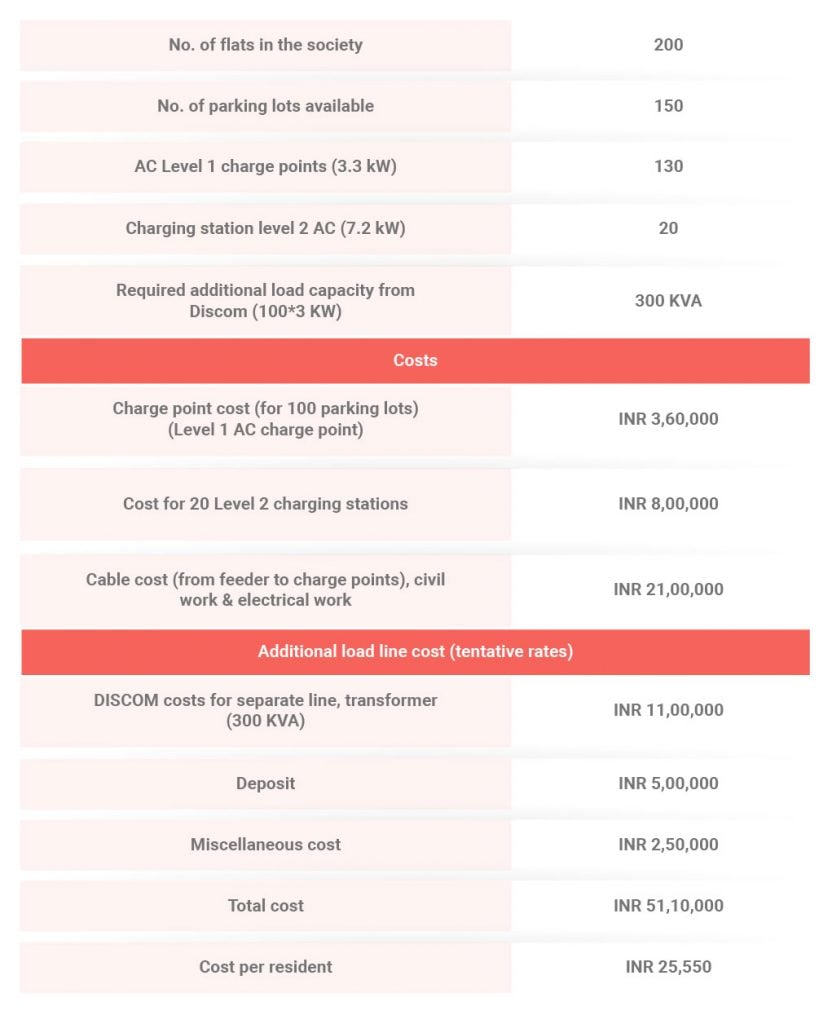
*These are approximate calculations & actual prices might vary from city to city based on local DISCOM costs
Content by Bolt Network and MyGate
All content in this article is the copyright of Vivish Technologies Pvt. Ltd.
About MyGate
MyGate is India’s #1 community app. It benefits thousands of housing societies, developers, society facility managers, and millions of homeowners in every Indian city with an ERP tool and a system for e-commerce players to better manage their deliveries. Founded by ISB/IIM/IIT alumni, MyGate has been named one of India’s Most Innovative Start-ups (by INC 42) and India’s Coolest Start-ups (by Business Today).
About Bolt Network
Bolt Network was founded with the dream of making electric vehicles more accessible by easing and accelerating the transition of emerging markets to cleaner mobility. Bolt Network has installed over 1,200 charging points across 60 Indian cities, services over 5,000 active monthly users and has an installed capacity of over 3,600 KW. The company aims to build a smart, safe and connected world for electric vehicle users with BOLT – the world’s largest peer-to-peer charging network.
